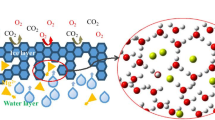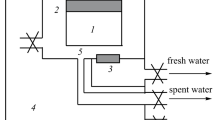Abstract
This paper is concerned with the melting of horizontal ice layer from above by aqua-solvent with low solidification point. The solute used in this experiment are Sodium chloride NaCl, Calcium chloride CaCl2, Magnesium chloride MgCl2, and Urea CO(NH2)2- The upper surface of aqua-solvent melt layer is heated by an infrared lamp, whose temperature is in the range of about 8 ‡C to 40 ‡C. The ice layer located under the aqua-solvent melt layer melts greatly by a combined effect of both thermal energy and chemical reaction, and the typical temperature distribution in both aqua-solvent and ice layer is examined. The relation between melt amount of ice layer per unit temperature gradient and mean concentration in aqua-solvent melt layer was obtained.
Zusammenfassung
Der Aufsatz behandelt das Aufschmelzen einer horizontalen Eisschicht von oben mittels einer wäßrigen Lösung niedrigen Gefrierpunktes. Die in diesem Experiment verwendeten Lösungen sind Natriumchlorid NaCl, Kalziumchlorid CaCl2, Magnesiumchlorid MgCl2 und Harnsäure CO(NH2)2. Die Oberfläche der wäßrigen Lösung und der Schmelze wurde mit einer Infrarotlampe beheizt, deren Temperatur bei 8–40 ‡C lag. Die unter dem Lösungsmittel liegende Eisschicht schmilzt durch kombinierte Einwirkung der Wärme als auch der chemischen Reaktion und es wird die Temperaturverteilung sowohl in der wäßrigen Lösung als auch in der Eisschicht untersucht. Die experimentellen Ergebnisse zeigen die Abhängigkeit der aufgeschmolzenen Eismenge vom Temperaturgradienten und der mittleren Konzentration in der wäßrigen Lösung.
Similar content being viewed by others
Abbreviations
- C :
-
concentration
- C m :
-
mean concentration in melt layer evaluated by melt amount of ice layer
- E :
-
thermal electric motive force (corresponding to temperature)
- L :
-
latent heat for melting
- M :
-
melting amount of ice layer per unit temperature gradient in melt layer
- Nu :
-
Nusselt number
- S :
-
melt thickness of ice layer
- t :
-
time
- T :
-
temperature
- T 1 :
-
temperature near top surface of melt layer
- T 2 :
-
temperature at solid-liquid interface
- y :
-
distance from upper surface of melt layer
- Y :
-
distance between location atT 1 and the one atT 2
- α :
-
effective heat transfer coefficient
- λ :
-
thermal conductivity of melt layer
- ϱ :
-
density of ice
- a :
-
aqua-solvent
- in:
-
initial
- w :
-
water
References
Rubinstein, L. I.: The Stefan Problem. 27 (1971). American Mathematical Society
Griffin, O. M.: Heat, mass, and momentum transfer during the melting of glacial ice in sea water. ASME J. Heat Transfer. 95–3 (1973) 317–323
Sammakia, B.; Gebhart, B.: Transport near a vertical ice surface melting in water of various salinity levels. Int. J. Heat Mass Trasnfer. 26–10 (1983) 1439–1452
Japan Society of Mechanical Engineers: JSME Data Book; Thermophysical Properties of Fluids (1983) 468
Author information
Authors and Affiliations
Rights and permissions
About this article
Cite this article
Sugawara, M., Inaba, H., Nishimura, H. et al. Melting of horizontal ice layer from above by combined effect of temperature and concentration of aqua-solvent. Wärme- und Stoffübertragung 21, 227–232 (1987). https://doi.org/10.1007/BF01004025
Received:
Issue Date:
DOI: https://doi.org/10.1007/BF01004025




